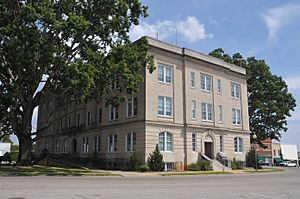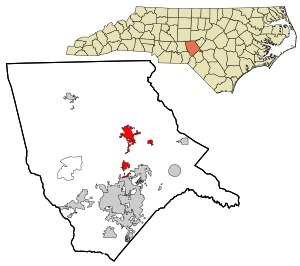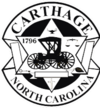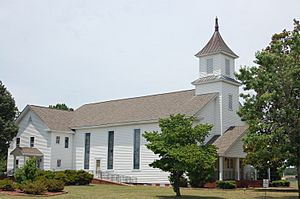Carthage, North Carolina facts for kids
Quick facts for kids
Carthage, North Carolina
|
||
|---|---|---|

Moore County Courthouse in Carthage
|
||
|
||

Location in Moore County and the state of North Carolina.
|
||
| Country | United States | |
| State | North Carolina | |
| County | Moore | |
| Founded | 1796 | |
| Incorporated | 1796 | |
| Named for | Carthage | |
| Government | ||
| • Type | council-manager | |
| Area | ||
| • Total | 6.70 sq mi (17.36 km2) | |
| • Land | 6.67 sq mi (17.26 km2) | |
| • Water | 0.04 sq mi (0.10 km2) | |
| Elevation | 538 ft (164 m) | |
| Population
(2020)
|
||
| • Total | 2,775 | |
| • Density | 416.35/sq mi (160.76/km2) | |
| Time zone | UTC-5 (Eastern (EST)) | |
| • Summer (DST) | UTC-4 (EDT) | |
| ZIP code |
28327
|
|
| Area codes | 910, 472 | |
| FIPS code | 37-00160 | |
| GNIS feature ID | 2406227 | |
| Website | www.townofcarthage.org | |
Carthage is a town in North Carolina, USA. It's the main town, or "county seat," of Moore County. In 2020, about 2,775 people lived there. The town got its name from the ancient city of Carthage.
Contents
History of Carthage
Carthage was once home to the Tyson & Jones Buggy Company. This company made many carts and buggies in the late 1800s.
There's a local story about Henry Ford. People say he wanted to buy the old buggy factory. But the owners supposedly said no. The legend says Ford then built his first car factory in Detroit. However, this story isn't true. Henry Ford was born in Detroit and started his car business there. The old buggy factory later burned down.
Another local story says Carthage was almost chosen for the University of North Carolina. The story claims town leaders didn't want the university. They supposedly said the hill was too steep for trains. This would make it hard to reach the university. But this story also isn't true. Trains weren't invented until 20 years after the university was built in Chapel Hill.
Buggy Festival
Every spring, Carthage holds a fun event called the Buggy Festival. It celebrates the town's history. You can see old buggies made by the Tyson Buggy Company. There's also music, cool hot rods, and old tractors. Local artists sell crafts, especially pottery. The festival happens in the town square. This area is around the Old Court House, which is a historic landmark.
Important People in Carthage History
William T. Jones was a partner in the Tyson & Jones buggy factory. He was born in 1833. By the time he passed away in 1910, he was a very successful business owner in Carthage. He was respected by many people in the community.
James Rogers McConnell was an aviator from Carthage. He flew planes during World War I. He was part of a group called the Lafayette Escadrille. He even wrote a book called Flying for France. James McConnell was shot down by German planes in 1917. He was the last American pilot in his squadron to die before the US joined the war. There are memorials for him in France and at the University of Virginia. There is also a monument in Carthage's town square.
Historic Buildings
Several buildings in Carthage are very old and important. They are listed on the National Register of Historic Places. These include the J.F. Cole House, J.C. Black House, Daniel Blue House, Bruce-Dowd-Kennedy House, Alexander Kelly House, and the Moore County Courthouse.
Geography and Climate
Carthage covers an area of about 6.7 square miles (17.36 square kilometers). Most of this area is land. Only a small part is water.
Weather in Carthage
| Climate data for Carthage, North Carolina, 1991–2020 normals, extremes 1981–present | |||||||||||||
|---|---|---|---|---|---|---|---|---|---|---|---|---|---|
| Month | Jan | Feb | Mar | Apr | May | Jun | Jul | Aug | Sep | Oct | Nov | Dec | Year |
| Record high °F (°C) | 77 (25) |
81 (27) |
88 (31) |
102 (39) |
97 (36) |
107 (42) |
104 (40) |
104 (40) |
96 (36) |
98 (37) |
84 (29) |
78 (26) |
107 (42) |
| Mean maximum °F (°C) | 71.0 (21.7) |
72.6 (22.6) |
81.0 (27.2) |
86.7 (30.4) |
90.1 (32.3) |
95.2 (35.1) |
96.4 (35.8) |
95.7 (35.4) |
91.9 (33.3) |
85.8 (29.9) |
78.3 (25.7) |
71.9 (22.2) |
98.3 (36.8) |
| Mean daily maximum °F (°C) | 52.6 (11.4) |
55.7 (13.2) |
65.2 (18.4) |
73.2 (22.9) |
80.4 (26.9) |
86.7 (30.4) |
90.3 (32.4) |
87.8 (31.0) |
83.3 (28.5) |
73.0 (22.8) |
64.0 (17.8) |
55.2 (12.9) |
72.3 (22.4) |
| Daily mean °F (°C) | 41.6 (5.3) |
44.0 (6.7) |
52.6 (11.4) |
60.0 (15.6) |
68.5 (20.3) |
76.0 (24.4) |
79.7 (26.5) |
77.6 (25.3) |
72.1 (22.3) |
61.1 (16.2) |
51.4 (10.8) |
44.2 (6.8) |
60.7 (15.9) |
| Mean daily minimum °F (°C) | 30.6 (−0.8) |
32.3 (0.2) |
40.0 (4.4) |
46.8 (8.2) |
56.5 (13.6) |
65.3 (18.5) |
69.1 (20.6) |
67.3 (19.6) |
60.9 (16.1) |
49.1 (9.5) |
38.7 (3.7) |
33.1 (0.6) |
49.1 (9.5) |
| Mean minimum °F (°C) | 13.8 (−10.1) |
19.4 (−7.0) |
23.1 (−4.9) |
33.0 (0.6) |
41.6 (5.3) |
56.7 (13.7) |
60.7 (15.9) |
59.0 (15.0) |
50.4 (10.2) |
35.7 (2.1) |
25.6 (−3.6) |
20.3 (−6.5) |
12.6 (−10.8) |
| Record low °F (°C) | 5 (−15) |
4 (−16) |
14 (−10) |
24 (−4) |
29 (−2) |
47 (8) |
51 (11) |
42 (6) |
41 (5) |
28 (−2) |
16 (−9) |
9 (−13) |
4 (−16) |
| Average precipitation inches (mm) | 3.93 (100) |
3.09 (78) |
4.12 (105) |
3.32 (84) |
2.95 (75) |
4.50 (114) |
4.72 (120) |
4.86 (123) |
5.67 (144) |
3.38 (86) |
3.61 (92) |
3.66 (93) |
47.81 (1,214) |
| Average snowfall inches (cm) | 0.7 (1.8) |
0.3 (0.76) |
0.2 (0.51) |
0.0 (0.0) |
0.0 (0.0) |
0.0 (0.0) |
0.0 (0.0) |
0.0 (0.0) |
0.0 (0.0) |
0.0 (0.0) |
0.0 (0.0) |
0.1 (0.25) |
1.3 (3.3) |
| Average precipitation days (≥ 0.01 in) | 8.3 | 7.2 | 7.8 | 6.8 | 6.7 | 8.2 | 8.7 | 8.4 | 6.7 | 6.4 | 6.6 | 7.5 | 89.3 |
| Average snowy days (≥ 0.1 in) | 0.4 | 0.2 | 0.1 | 0.0 | 0.0 | 0.0 | 0.0 | 0.0 | 0.0 | 0.0 | 0.0 | 0.1 | 0.8 |
| Source 1: NOAA | |||||||||||||
| Source 2: National Weather Service | |||||||||||||
People of Carthage
| Historical population | |||
|---|---|---|---|
| Census | Pop. | %± | |
| 1880 | 366 | — | |
| 1890 | 485 | 32.5% | |
| 1900 | 605 | 24.7% | |
| 1910 | 863 | 42.6% | |
| 1920 | 962 | 11.5% | |
| 1930 | 1,129 | 17.4% | |
| 1940 | 1,381 | 22.3% | |
| 1950 | 1,194 | −13.5% | |
| 1960 | 1,190 | −0.3% | |
| 1970 | 1,034 | −13.1% | |
| 1980 | 925 | −10.5% | |
| 1990 | 976 | 5.5% | |
| 2000 | 1,871 | 91.7% | |
| 2010 | 2,205 | 17.9% | |
| 2020 | 2,775 | 25.9% | |
| U.S. Decennial Census | |||
Population Details
In 2020, Carthage had 2,775 residents. The town has been growing. Since 2010, its population has increased by almost 20%. About 397 people live in each square mile of Carthage.
The average household income in Carthage is about $59,183. The poverty rate is around 11.67%. Rent for a home is usually about $727 per month. The average house value is $173,900. The average age of people in Carthage is 43.3 years old.
| Race | Number | Percentage |
|---|---|---|
| White (non-Hispanic) | 1,897 | 68.36% |
| Black or African American (non-Hispanic) | 415 | 14.95% |
| Native American | 31 | 1.12% |
| Asian | 10 | 0.36% |
| Pacific Islander | 1 | 0.04% |
| Other/Mixed | 158 | 5.69% |
| Hispanic or Latino | 263 | 9.48% |
Notable People from Carthage
- Lucean Arthur Headen (1879–1957) was an African-American aviator, inventor, and business owner.
- U.S. President Andrew Johnson lived in Carthage when he was a teenager.
- Mable Parker McLean (1922–2012) was an important leader in education.
See also
 In Spanish: Carthage (Carolina del Norte) para niños
In Spanish: Carthage (Carolina del Norte) para niños



